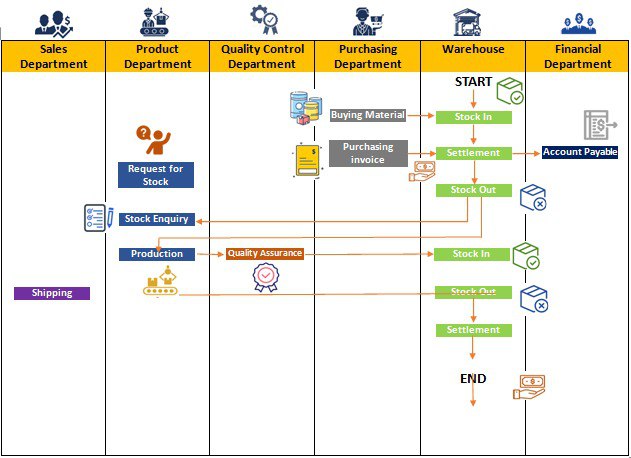Inventory control is the manner of successfully overseeing the go with the drift of products inside a business. It involves effectively balancing the supply and demand of inventory to optimize operational efficiency and customer satisfaction. The key objectives of inventory management include minimizing stockouts, reducing carrying costs, and maximizing profits. By implementing robust inventory control systems, businesses can accurately track and analyse inventory levels, forecast demand, and determine reorder points. Effective stock control guarantees that the proper merchandise is to be had on the proper time, minimizing excess inventory, and avoiding shortages, thus enabling businesses to meet customer needs while maintaining cost-effectiveness.
Inventory Management Process Flow:
Are you Struggling to cope with any of these Inventory Issues?
Inventory management is a critical aspect of any business that involves the acquisition, storage, and utilization of raw materials, work-in-progress, and finished goods. Effective inventory management ensures that a company maintains optimal inventory levels, minimizing costs while meeting customer demands. However, many businesses face various inventory management issues that can significantly impact their operations and overall profitability.
In this article, we will explore common inventory management issues and their potential implications.
Manual inventory monitoring methods using several spreadsheets and activities are time-consuming, redundant, and prone to mistakes. Even small firms might profit from a centrally located inventory monitoring system with accounting capabilities.
Controlling inventory at the warehouse is a labour-intensive process that includes picking, packing, and shipping as well as receiving and put away. The tricky part is accomplishing all these things as effectively as you can.
You must always be aware of the precise amount of goods you have. The days of conducting an all-hands-on-deck inventory count once a year are long gone.
Consumer demand is repeatedly changing. conserving too little could prevent you from filling customer orders, while storing too much might cause you to build up outdated inventory that you cannot sell. Using technology to design and carry out an inventory strategy, as well as order tactics for essential commodities, can assist offset demand swings.
Shipments that are late, inaccurate, or incomplete are caused when your product is difficult to detect or identify in the warehouse. For effective warehouse operations and satisfying customer experiences, the proper goods must be received and located.
Managing inventory by hand requires a lot of paperwork and is unsafe. Additionally, it is difficult to scale across several warehouses with a lot of goods.
Specific care and storage plans are required for perishable and fragile stock. In addition, specific loss-prevention strategies and inventory controls must be implemented for high-value inventory.
Your inventory planning and management activities are hampered by the daily shifts in global supply chains. Manufacturers and wholesalers who control where, when, and how your merchandise is shipped demand flexibility and provide erratic lead times.
Managing space effectively is a daunting task. Utilising inventory management tools to plan and build warehouse spaces enables you to better manage the schedule of new stock deliveries. It can consider vital factors like availability of space.
Preventing product oversales and inventory runs out is one of the most frequent obstacles to effective inventory management. You can predict consumer orders with accuracy by using historical and periodic trends.
The competition for raw resources is impacted by the unpredictability of market forces and economic fluctuations in globalised supply chains. Sometimes small businesses must decide between competing for in-demand commodities or keeping a sufficient amount of inventory to keep prices in check.
To cut waste, compostable packaging—or doing away with packaging altogether—presents new challenges for warehouse layout and storage. It might even entail buying new machinery or reducing the shelf life of some goods.
A lot of online retail tactics do away with the necessity for massive warehouse distribution centres. These tactics facilitate product portfolio diversification and inventory expansion, but they necessitate resources and technologies for placing orders, shipping, and tracking.
Holding too much inventory on hand can be just as problematic as not enough. Overstock negatively impacts a company's cash flow and can result in inventory-related challenges like storage and loss.
A supply chain issue occurs when inventory is lost due to theft, damage, or spoiling. It necessitates the detection, monitoring, and measurement of problem regions.
Effective production planning is necessary for preventing cost overruns and delayed manufacturing. It might affect project schedule and sales estimates if not done properly.
It can be hard to find inventory managers with the latest technological expertise and the ability to boost inventory strategy. You require competent management.
Collaboration and communication are essential. It is far more difficult to recognize inventory trends and find approaches to improve when departments are apathetic about exchanging information.
When inventory is little and there is only one warehouse to supervise, low-tech, manual inventory management techniques do not look like a difficult task. However, it gets more challenging to scale unsuitable, labour-intensive, and low-tech standard operating procedures as sales volume and inventory grow.
Inventory management software must interact with your current business process platforms in order to scale to accommodate complicated logistics. Deciding from among hundreds of inventory management solutions and learning a variety of features that demand training and continuous assistance is a challenging undertaking.







